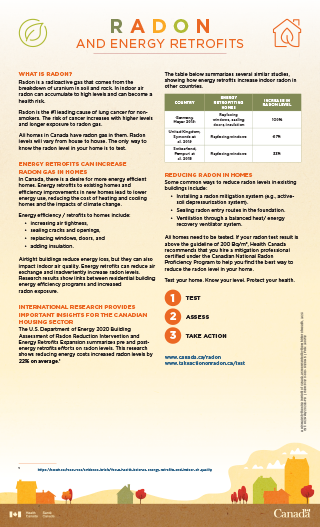Radon and energy retrofits

Download the alternative format
(PDF format, 905 KB, 1 page)
Organization: Health Canada
Published: 2023-10-23
What is radon?
Radon is a radioactive gas that comes from the breakdown of uranium in soil and rock. In indoor air radon can accumulate to high levels and can become a health risk.
Radon is the #1 leading cause of lung cancer for non-smokers. The risk of cancer increases with higher levels and longer exposure to radon gas.
All homes in Canada have radon gas in them. Radon levels will vary from house to house. The only way to know the radon level in your home is to test.
Energy retrofits can increase radon gas in homes
In Canada, there is a desire for more energy efficient homes. Energy retrofits to existing homes and efficiency improvements in new homes lead to lower energy use, reducing the cost of heating and cooling homes and the impacts of climate change.
Energy efficiency / retrofits to homes include:
- increasing air tightness,
- sealing cracks and openings,
- replacing windows, doors, and
- adding insulation.
Airtight buildings reduce energy loss, but they can also impact indoor air quality. Energy retrofits can reduce air exchange and inadvertently increase radon levels. Research results show links between residential building energy efficiency programs and increased radon exposure.
International research provides important insights for the Canadian housing sector
The U.S. Department of Energy 2020 Building Assessment of Radon Reduction Intervention and Energy Retrofits Expansion summarizes pre and post- energy retrofits efforts on radon levels. This research shows reducing energy costs increased radon levels by 22% on average.Footnote 1
The table below summarizes several similar studies, showing how energy retrofits increase indoor radon in other countries.
| Country | Energy retrofitting homes | Increase in radon level |
|---|---|---|
| Germany, Meyer 2019: | Replacing windows, sealing doors, insulation | +100% |
| United Kingdom, Symonds et al. 2019 | Replacing windows | + 67% |
| Switzerland, Pampuri et al. 2018 | Replacing windows | +33% |
Reducing radon in homes
Some common ways to reduce radon levels in existing buildings include:
- Installing a radon mitigation system (e.g., active-soil depressurization system).
- Sealing radon entry routes in the foundation.
- Ventilation through a balanced heat/ energy recovery ventilator system.
All homes need to be tested. If your radon test result is above the guideline of 200 Bq/m3, Health Canada recommends that you hire a mitigation professional certified under the Canadian National Radon Proficiency Program to help you find the best way to reduce the radon level in your home.
Test your home. Know your level. Protect your health.
- Test
- Assess
- Take Action
Learn more about: